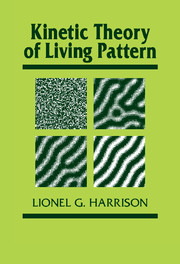Book contents
- Frontmatter
- Contents
- Preface
- Part I Macroscopics without mathematics
- 1 Introduction
- 2 Morphogen: one word for at least two concepts
- 3 Pictorial reasoning in kinetic theory of pattern and form
- 4 Structure, equilibrium, kinetics
- Part II Pattern-forming processes
- Part III Bringing experiment and theory together
- References
- Index
4 - Structure, equilibrium, kinetics
Published online by Cambridge University Press: 22 September 2009
- Frontmatter
- Contents
- Preface
- Part I Macroscopics without mathematics
- 1 Introduction
- 2 Morphogen: one word for at least two concepts
- 3 Pictorial reasoning in kinetic theory of pattern and form
- 4 Structure, equilibrium, kinetics
- Part II Pattern-forming processes
- Part III Bringing experiment and theory together
- References
- Index
Summary
What is the ultimate reality in terms of which scientific explanations should, at the deepest level, be written: matter or motion? Scientific philosophy has most commonly asserted that it is the latter. D'Arcy Thompson (1917) quoted instances of this starting from Aristotle's concept of the “efficient cause” and proceeding by way of Newton to a statement by F. G. FitzGerald that “all explanation consists in a description of underlying motions.” But in the same chapter, Thompson indicated that an accepted axiom of biology at that time was that “function presupposes structure.” And he also stated that “the over-whelming progress of microscopic observation has multiplied our knowledge of cellular and intracellular structure; and to the multitude of visible structures it has often been easier to attribute virtues than to ascribe intelligible functions or modes of action.” This seems curiously modern for something written long before theories of motion had arrived at the wave nature of the electron and so made possible the structural revelations of the electron microscope.
Thompson could have had no inkling that such “overwhelming progress” was only the beginning of the possibilities of microscopy. He envisaged, rather, that there would soon be a concentration of effort on dynamics, in which “the things which we see in the cell are less important than the actions which we recognize in the cell.” In the event, the infant microscopy of 1917 metamorphosed into an adult capable of finding more things in the cell than were dreamed of in Thompson's philosophy.
- Type
- Chapter
- Information
- Kinetic Theory of Living Pattern , pp. 89 - 142Publisher: Cambridge University PressPrint publication year: 1993



